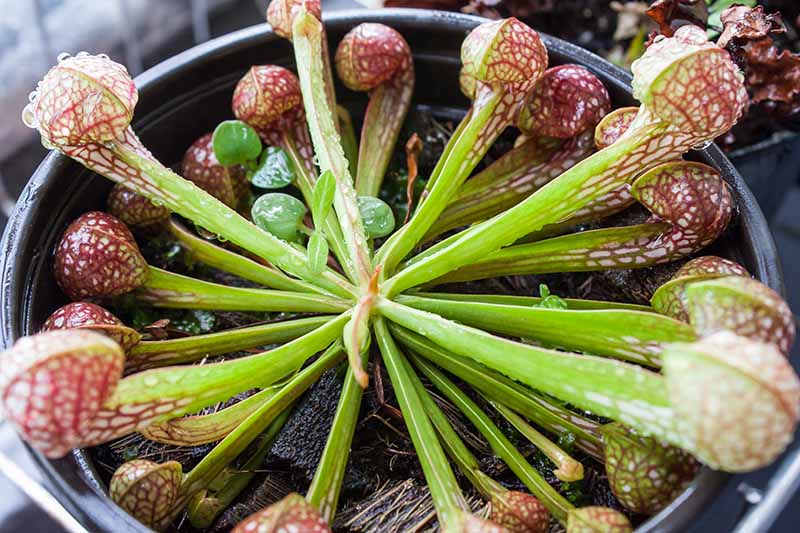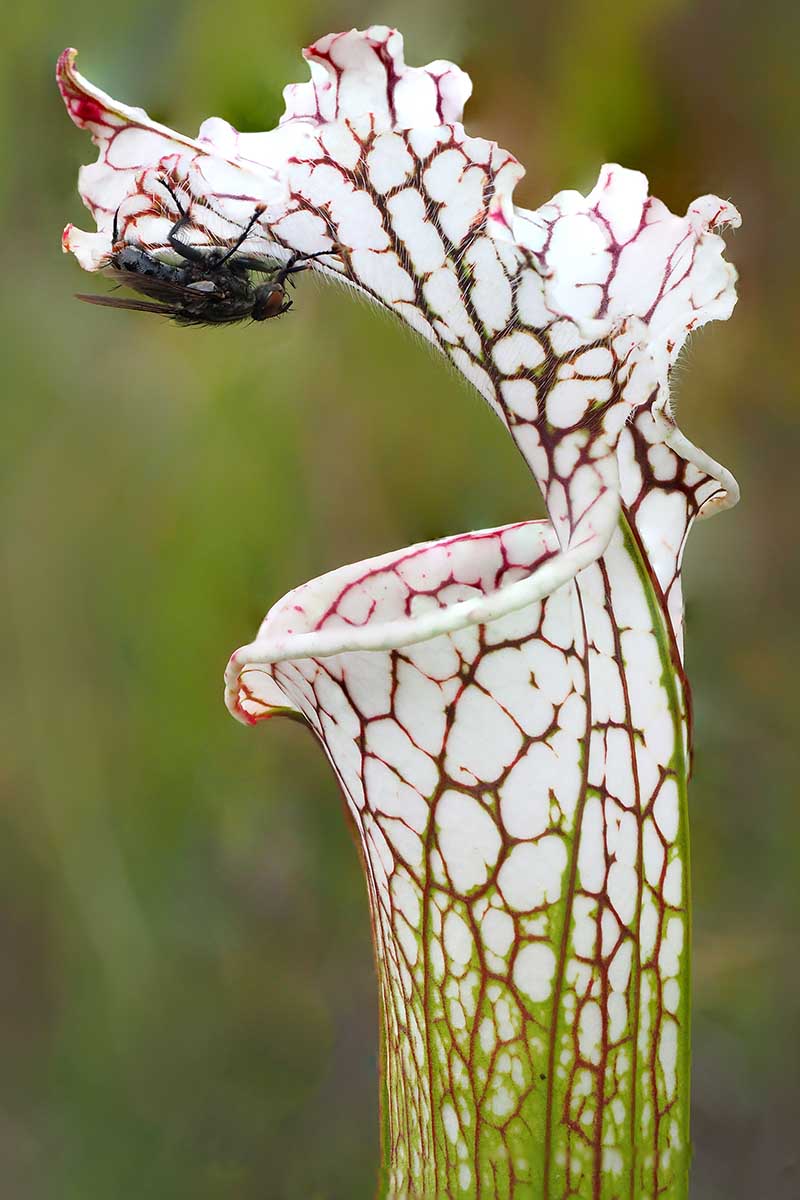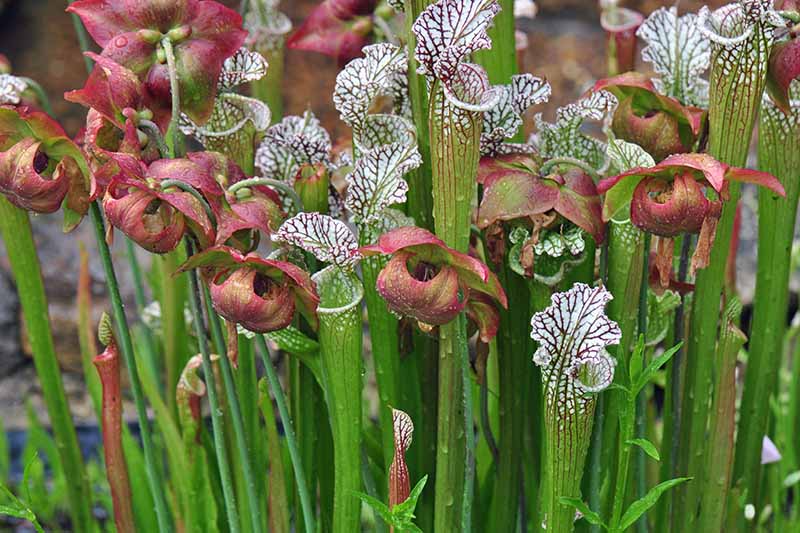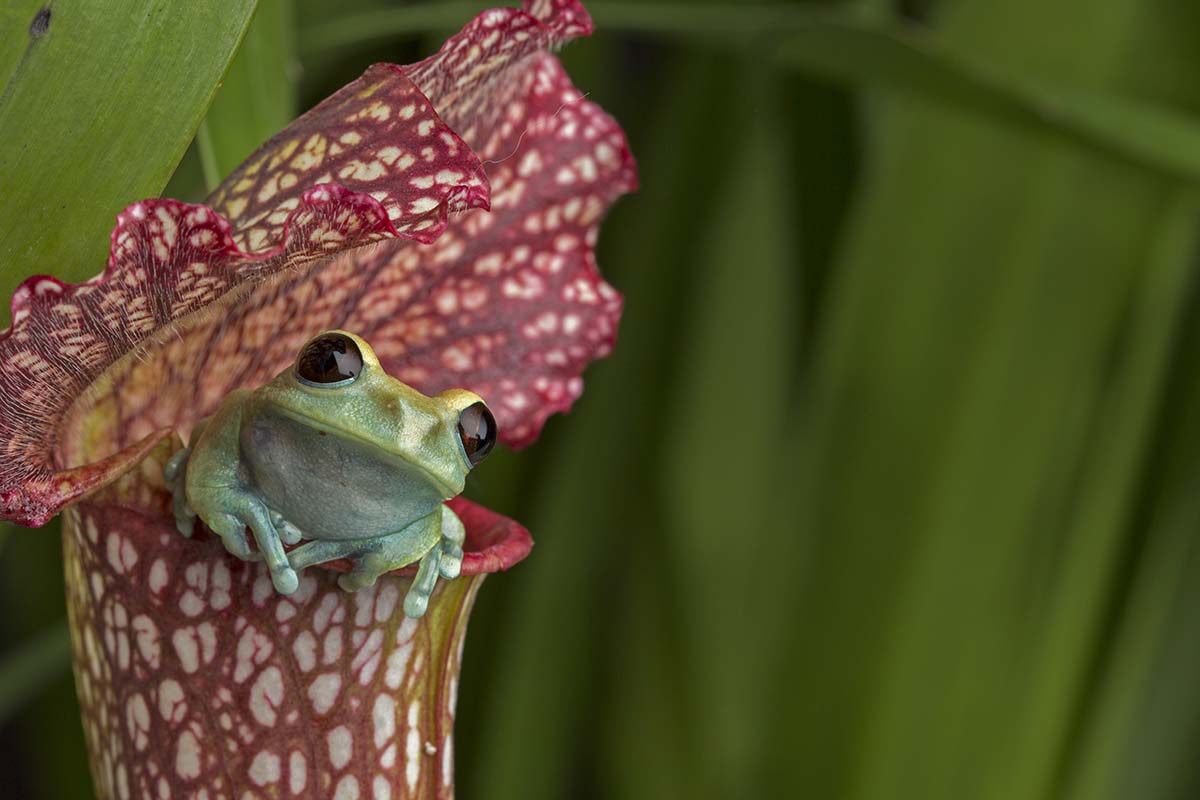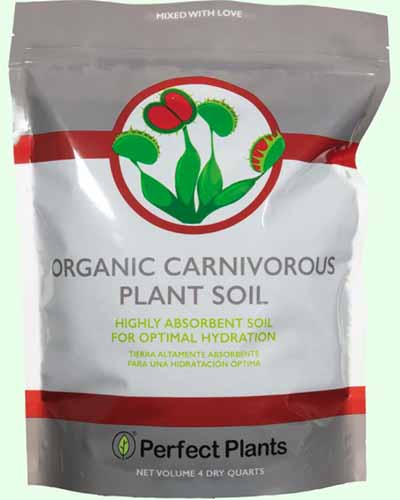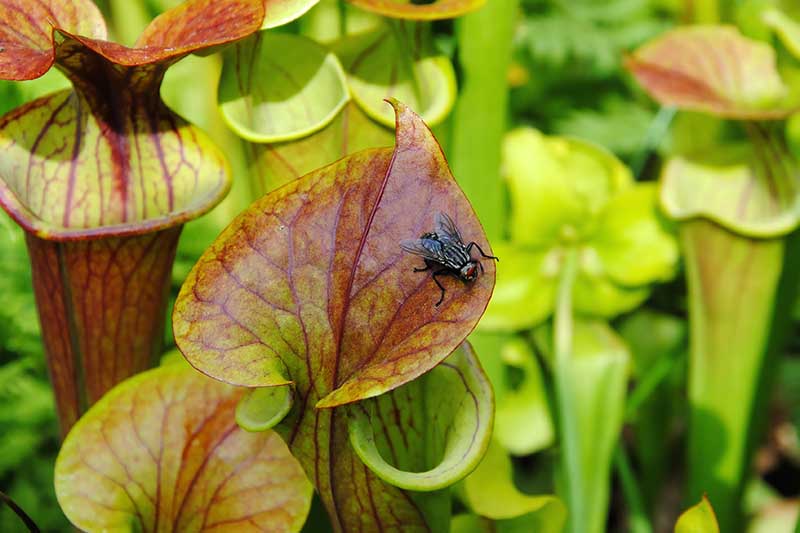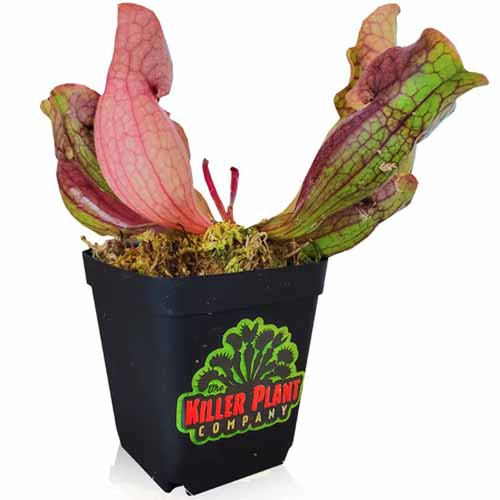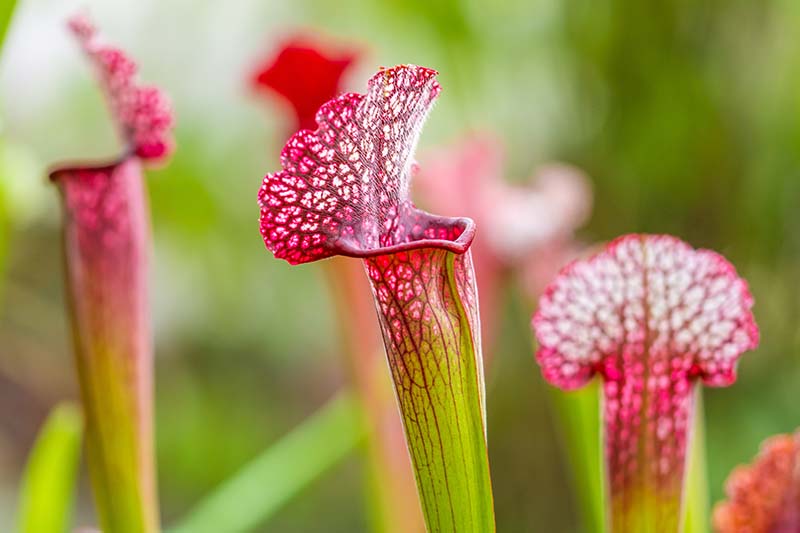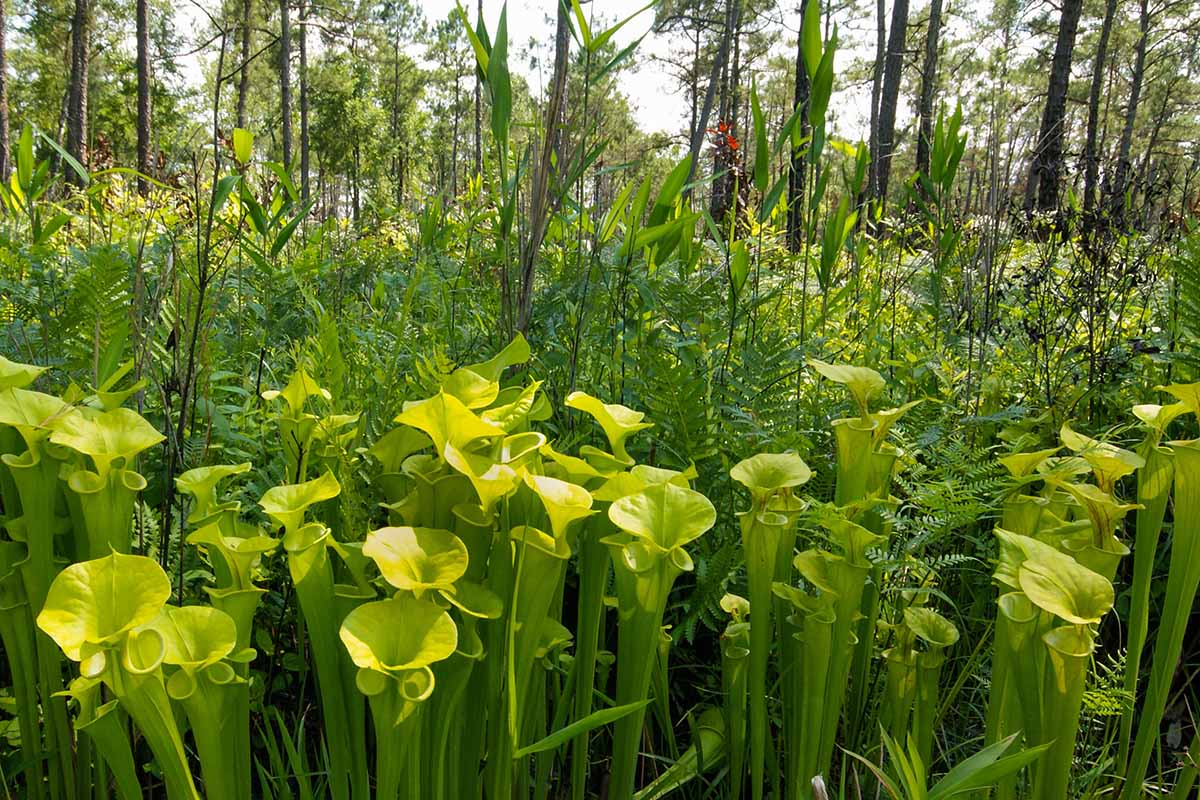When it comes to these beloved, mystical tubes that grow like swaths of deadly party favors, their preference is for conditions that other types of vegetation can rarely tolerate, growing only in wetlands and bogs. These highly specialized environments have a high water table and primarily a peat moss substrate. So, if you’ve seen pitcher plants in someone’s yard, they either had the proper conditions available already, or they did some prep work to provide them. We link to vendors to help you find relevant products. If you buy from one of our links, we may earn a commission. Let’s talk about how to replicate these conditions, and propagate, grow, and care for these plants, so they can happily lure insects to a watery death. Here’s what we’ll cover:
What Is a Pitcher Plant?
The Sarracenia genus includes at least eight known species of pitcher plants indigenous to North America, although some botanists recognize several more. All of these grow in bogs and pine savannas from the southeastern United States between Texas and Florida up the eastern seaboard to Canada. Some species can be found in swamps and near natural springs, or adjacent to lakes and riverbeds. When many people think of a bog or wetland, they imagine flooded marshes where roots are submerged in mud, and foliage grows directly from the pooled water. Some plants do prefer to grow in these conditions, such as cattails or water lilies, but this is not usually the case. Most of these environments are adjacent to bodies of water, with acidic, low-fertility ground that is typically moist, but not saturated at all times. Species that call these places home derive moisture from the water table belowground. While most Sarracenia species favor the warm temperatures found in USDA Hardiness Zones 7 to 10, some – like S. purpurea, the purple pitcher plant – can tolerate winter lows ranging down to about -10°F, and can therefore be found further north. More than half of the known temperate species in North America are found growing wild in Florida, where they live in the sunny, open-canopy wetlands that the state is known for. Rolled leaves that form trumpet-shaped “pitfall” traps are the most easily recognized characteristic of the plants in this genus. They sprout from underground rhizomes, or tuberous roots, in the springtime, forming clusters arranged like organ pipes that pop up from the boggy ground. S. minor, the hooded pitcher plant, is notable for its downward-facing hooded lid that partially covers the opening to the trap. The parrot pitcher plant, S. psittacina, employs a different method for trapping insects than other species in this genus. It has a prostrate growth habit, with its pitchers flat against the ground, like tunnels for unsuspecting prey. This is known as a “lobster pot” trap. Pitcher height varies widely between species, with S. purpurea reaching only about eight inches total, while S. flava can be over 36 inches tall at maturity. Smaller types do not typically spread beyond 12 to 16 inches for a single plant, though clusters that grow together can spread far wider. Taller species also have a wider spread, sometimes well over three feet. Typically, most species experience active growth between spring and summer, until they die back to the ground and go dormant in the fall. Adapted to survive in nutrient-deficient acidic soil, their leaves evolved to form a way to attract prey. Their form and colors present an air of cheerfulness despite their macabre purpose. Nectaries, or node-like glands, are arranged around or above a waxy, rolled lip at the opening of each tube, where they secrete nectar that runs downward on both the inside and outside of the leaves. Above the opening, a hood-like leaf that appears on most species, called the operculum, protects the tube from filling up during heavy rain and guides prey insects inside. Some species, however, such as S. purpurea, actually use rainwater to aid in trapping prey. The nectar that lures insects such as ants, bees, beetles, and wasps, as well as slugs and snails, is intoxicating – quite literally. It contains a narcotic that causes paralysis. Color also acts as an attractor, and anthocyanins and carotenoids create red, pink, purple, and yellow tones that signal the presence of a food source to passing insects. The interior funnel of the tubes is waxy and slippery, making it difficult for insects to grip, and downward-facing hairs are arranged in a way that makes them nearly inescapable. Insects that enter tend to slide down into the tube to the base where a pool of digestive acids and enzymes awaits. As they struggle to free themselves, they either drown or die from overexertion. As the insect is digested in the fluids, nutrients including nitrates and phosphates are drawn from it. Unlike other carnivorous plants that typically spend anywhere from a few days to a few weeks processing their prey, these insects will continue to provide food to the pitcher until the leaf dies off – a process that can take two weeks to a couple of months. Most species produce blooms that mature after pollination to form pods that burst open to scatter the tiny seeds inside. Blooms typically appear between April and May, although S. leucophylla may also produce blooms in the fall. The unusual blooms have nodding heads, with petals that drape around the stamens. They typically appear before the trumpets, and grow on taller stems to separate the traps from the blooms to avoid accidentally trapping pollinators. Learn more about Sarracenia blooms in our guide. (coming soon!) Other species may also be referred to commonly as pitcher plants. In fact, pitcher traps have actually evolved independently in various branches of the plant kingdom at least six times. Pitcher plants fall into three botanical families. The neotropical pitcher plant family, Sarraceniaceae, also includes the Darlingtonia and Heliamphora genera. Darlingtonia californica aka cobra plant, cobra lily, or California pitcher plant is native to wetland areas in northern California and southern Oregon. These striking plants resemble the head of a cobra, with a rounded trap and two distinctive snake-like “fangs” below the entrance to the pitcher. Species in the genus Heliamphora are commonly known as sun or marsh pitcher plants, and they are native to mountainous regions of Brazil, Guyana, and Venezuela. Native to Asia, Australia, and Madagascar, the palaeotropical pitcher plant family, Nepenthaceae, includes one genus, Nepenthes, of which there are over 100 species. You may also come across the Albany pitcher plant, Cephalotus follicularis. It is the only member of its genus, and belongs to the Cephalotaceae family. It’s native to southwestern Australia. Species belonging to the tropical Nepenthes genus are frequently cultivated indoors. We cover them separately in our guide to growing Nepenthes pitcher plants.
Cultivation and History
The genus Sarracenia is named after French surgeon Dr. Michael Sarrazin. In the late 17th century, he traveled from France to what is now known as Canada with the colonizing troops. He became enamored with many of the native plants, especially the carnivorous specimens he found on the east coast. He sent samples of some of these to the French Academy of Sciences for study, where the botanists on staff concluded that the pitcher plants were merely harboring insects, rather than consuming them as prey. Prior to 1815, it was believed that the tube-shaped structure of the leaves was designed to allow insects and animals, such as frogs, to hide inside. It wasn’t until botanists began to study them more closely that they realized the insects, and sometimes even frogs, that entered the tubes tended to drown in the liquid at the bottom, which was initially believed to be harmless pooled rainwater. In 1815, James MacBride, a botanist at the Field Museum of Natural History in Chicago, Illinois, began experimenting on S. purpurea and discovered that this species was actually luring and trapping insects for later digestion. This scientific breakthrough led to the study of more pitcher plant species, their anatomy, and their habitats. In their native environments, the wet, humid climate plays host to other carnivorous plants such as Venus flytraps and sundews, as well as a vast array of insects and wildlife. Sadly, little of the native wetland habitat for Sarracenia remains in the United States, as bog conditions are unfortunately undesirable to many people. Developers have drained and built new construction in these environments, and wiped out much of the unique flora and fauna that once inhabited the areas. Because of this disregard for their natural environment, five of the six species known to inhabit the State of Florida are listed as threatened or endangered. This serves as a reminder to always purchase plants or seed from ethical growers, as poaching further reduces the number of pitcher plants found in the wild. Let’s take a look at how propagation can be achieved ethically for home-growing in your landscape.
Propagation
While some species can technically be grown from rooted leaf cuttings, it’s not always successful and doesn’t work for most types. For our purposes, we’re going to focus on the methods that work best. There are two primary methods of propagating pitcher plants: growing from seed, and from rhizome division. However, note that starting from seed means you’ll have to wait four to six weeks for the seeds to germinate, and another three to four years before they mature enough to bloom. Seeds also do not always grow true to the parent. It’s definitely easier to add these to the landscape or bog garden by purchasing and dividing mature specimens to produce clones, if your goal is to clone parental characteristics. Be sure to source them, and seed as well, from growers who cultivate captive specimens rather than poaching from the wild. Always be sure to use distilled or rainwater only, as they contain nutrients and minerals at low enough levels to avoid causing damage or die-off. Organic Carnivorous Plant Soil A four-quart package of organic carnivorous potting medium can be purchased from Home Depot. You can also combine one part peat moss or coconut coir and one part sand or perlite, but be sure to rinse all materials well in distilled water to remove any impurities they might contain before potting. Use only materials that do not contain added fertilizers. For complete information on propagating pitcher plants, see our comprehensive guide. (coming soon!)
From Seed
Seed is produced between late summer and early fall. When the blossoms have been pollinated in the spring, pods form that take several months to mature. It can take about one to two years before they are ready to move to their permanent location outdoors, and you’ll need to harden them off in the spring to make sure they’re prepared for outdoor growing. To do this, line a plastic container with a paper towel lightly moistened with distilled water. Spread the seeds evenly, and cover with a second paper towel, also dampened with distilled water. Cover the container with an airtight lid, and place it in the refrigerator for six to eight weeks. Planter Nursery Pots Add two to four seeds to each pot, spaced about one inch apart, leaving them on the surface, and cover lightly with sand no more than an eighth of an inch deep. Provide warmth and humidity, and be sure that the potting medium stays moist. You’ll see sprouts within four to six weeks. When outdoor temperatures are about 60 to 70°F during the day, move the seedlings outdoors to a shady location for a couple of hours. Over the course of the next few days to a week, move them gradually into direct sunlight and leave them outdoors for longer periods until they’re fully acclimated to being outside. Seeds can also be started outdoors in six-inch pots in the fall, which allows for natural cold stratification. Place the pots in a protected location where they won’t be battered by heavy rain, and expect germination in the spring.
From Rhizome Divisions
Before new growth sprouts in the spring, you can divide and replant crowded rhizomes to create multiple plants. The best time to divide is in late winter during dormancy, as the potential for causing shock is significantly reduced. Mature specimens of at least three years of age respond more favorably to division. The rhizomes may not be easy to separate. You may be able to divide some of them simply by pulling them apart, or you may need to use garden shears or a knife to divide thicker, more mature ones. Once they’re separated, use carnivorous plant potting mix to fill pots that are about two inches larger than the previous ones. If you’re planting in the ground, prepare the site by adding fresh peat and sand. In both instances, ensure the medium is moist when you replant. Place the divided rhizomes back in the same location, or move them to another spot with similar conditions so they can finish their dormant cycle. They’ll be ready to sprout and begin anew in the spring.
From Seedlings/Transplanting
Seedlings look like tiny versions of their adult counterparts, since the first true leaves that develop are pitchers. At one to two years old, they’ll be strong and mature enough to transplant outdoors, provided you live in a suitable region. Purchased plants can be transplanted following these instructions as well, as they’re most likely at least one year old already. Prepare a sunny site with a suitable growing medium as previously described, and water well. Make holes the same width and depth as the rhizome and root system. If you purchased bare roots, unwrap and place the rhizomes in a shallow dish of distilled water for 30 minutes to an hour prior to transplanting. Gently turn potted plants out of their pots, inspect to make sure there are no signs of rotting or infestation, and immediately place them in the holes. Press them in with your hands to secure, and water in well. For bare root transplants, be sure to leave the crown above surface level to avoid planting the rhizome too deeply.
How to Grow
Location is one of the most important considerations you’ll need to make when planting Sarracenia. Adequate direct sunlight is imperative. Without it, they’ll die – and that is not an exaggeration. After hardening off transplants, keep them in full sun for at least eight hours per day, but aim for 12 to 16. Because these are bog plants that grow in nutrient-deficient conditions, you don’t need to apply fertilizer – in fact, this can actually damage or kill them. Instead, you should allow them to lure their own prey outdoors. Avoid wetting the exterior of the pitchers, as they may wilt and tip over if they become too wet or too full. Bear in mind that these are delicate leaves. One to two inches of fresh distilled or rainwater should be provided as needed, to maintain consistent moisture. Be sure to check the moisture level daily during periods of warm weather in the spring and summer. If you already have wetlands on your property, you can simply place them in a full-sun area with ground that stays moist, but not in a space that is constantly flooded or saturated. If you don’t, you can build your own miniature wetland with pitcher plants and other species that thrive in similar conditions. Learn how to plan, build, and maintain your own bog garden in our guide to creating a carnivorous plant garden.
Growing Tips
Plant in an area with full sun and boggy conditions.Use only distilled water or rainwater, as other types can contain too many nutrients and minerals.Maintain consistent moisture and never allow the soil to dry out.Be prepared to move dormant plants of all species except S. purpurea indoors or to a protected area if your region has seasonal lows below freezing.
Pruning and Maintenance
Just as with other blooming plants, you should deadhead the spring blooms once they’re spent if you’re not planning to collect seed. Leaves that are dead or dying can also be snipped off with sharp, clean scissors or pruning shears. Removing dying foliage will divert energy to producing new shoots and supporting the healthy parts that remain. It can also reduce the likelihood of infestation, as it reduces the availability of hiding places for pest insects and their eggs. Every three to four years, divide rhizomes that have formed a cluster. This will lessen crowding and prevent pathogens from harboring in wet, compacted material – and it’s also a good time to refresh the potting medium in container plantings. Pitchers less than one inch in diameter don’t need to be fed. If you notice that insects haven’t been caught in the larger pitchers at least every two to three weeks, you can feed them dehydrated bloodworms, such as those available at aquarium supply stores. Reconstitute them by adding a few drops of water to a small clump of worms placed in a small dish or bottle cap, and drop them into the tubes a few at a time. Insects that become stuck on the inside of the pitcher can cause inflammation, much like indigestion in humans. If you notice that some of the worms have gotten stuck on the inside wall of a tube, use an eyedropper filled with distilled water to add a few drops at a time, allowing the droplets to run down the side and wash them into the fluid below. In the fall, as the foliage dies back to prepare for dormancy, you’ll want to move the rhizomes into a protected area if your region experiences temperatures below freezing. In zones where winter temperatures don’t fall below freezing, they can be left outdoors year-round. Even dormant rhizomes will need consistent moisture, so be sure to continue to water as needed, to keep the soil moist. Avoid overwatering, however, as it can lead to diseases, including root rot. Read up about caring for dormant rhizomes in our guide to winter pitcher plant care.
Varieties to Select
There are a number of cultivars and varieties available on the market, and some are especially glorious. Some of these are derived from natural variations that were discovered and cloned for cultivation. Variation among Sarracenia is common because the structure of the blossoms prevents self-pollination, so be prepared for cross-pollination leading to potential differences in yours as well if you opt to save seeds and sow them! Others were bred specifically to enhance certain features, such as hardiness, striking color, and unusual growth habits. Let’s take a look at a few of the top picks.
Managing Pests and Disease
Pests and diseases are common problems in both the garden and the landscape, and even though there aren’t many that will snack on or infect your pitcher plants, you’ll want to keep an eye out for just a few. S. flava var. maxima is visually arresting because of its minimalism. The elegant, trumpet-shaped pitchers are slender and shocking yellow-green at maturity. Young plants can have red tips that fade over time. S. flava var. maxima The pitchers reach about 16 to 18 inches in height, with blossoms on stems reaching 18 to 22 inches tall. This type also develops flat leaves known as phyllodia that remain through the winter in temperate climates.
Tarnok
While most Sarracenia species produce odd-looking blooms, S. leucophylla var. tarnok goes above and beyond, sending up green and red whorl-shaped blossoms in the fall that resemble soft pinecones. This cultivar was discovered by and named after Coleman Tarnok in Baldwin County, Alabama in 1973, who brought a specimen home to add to his carnivorous plant bog. S. leucophylla var. tarnok Plan to allow 24 inches for pitcher height and a stem length of up to 36 inches for blooms wherever you plant these, and get ready for a show, as the pitchers mature to a deep burgundy with heavily veined white tops!
Venosa
Varieties of S. purpurea are hardier than other species, and the subspecies venosa is a good example of this. S. purpurea subsp. venosa can tolerate light shade, and cooler winter temperatures down to about 20°F. It’s also compact, growing six to eight inches in height except for the blooms, which form on stems that can reach about 10 inches in height. While the trumpets are a bit smaller than those of other varieties, they do tend to grow outward rather than upward, so each cluster can have a spread of 12 to 16 inches at maturity. S. purpurea subsp. venosa The red variety starts off bright green and gradually changes to tones of striking purple, burgundy, and red, with deep veining with full sun exposure. One- to two-year-old six-inch bare root plants in three-inch pots filled with sphagnum moss are available from Killer Plant Company via Home Depot. Let’s talk about the most common culprits and how to stop them from causing major damage. You can expect that many of the pests you might see are common insects that appear on a wide variety of plants, and unfortunately, Sarracenia can also be a target for the same ones that show interest in soft, juicy vegetables such as lettuce and tomatoes. Aphids, mealybugs, scale, slugs and snails, and thrips are the primary nuisances that you may need to fend off throughout the growing season. While you may have experience with all of these if you’ve dealt with ridding your yard or garden of them in the past, controlling them on a more delicate plant can be a challenge that requires trying some new methods. The same holds true for disease. Whereas you may have experience with botrytis and root rot, finding a resolution is not quite the same when it affects a plant that can’t tolerate harsh chemicals. Learn more about controlling pitcher plant pests and disease in our guide. (coming soon!)
Best Uses
Let’s discuss where to place these beauties for maximum impact and enjoyment. The obvious choice is in a bog garden that you plan out carefully, and I suggest creating a list of acceptable companion plants to accompany your pitchers as they can make a truly magical, mutually beneficial combination. It may seem like there aren’t many that would grow in the same conditions, but that simply isn’t true – you have a fair variety to choose from. Venus flytraps and sundews, as I previously mentioned, are perfect companions as they all feed on insects. What one can’t trap or digest, the others would relish. Other suitable companion plants include orchids such as tuberous grasspinks, lady slippers, and pogonias; butterworts; water irises; and even bog rosemary. Bamboo is suitable, but it also tends to become invasive. Get creative and build a small habitat that not only looks wonderful, but that is filled with plants that thrive together. You can also put an otherwise useless wet ditch or low-lying area to work. It could be the perfect planting spot, provided it receives direct sunlight for at least 12 hours per day. Not only will pitcher plants thrive in those conditions, they’ll also use up some of the excess moisture – a win-win situation! Just be sure that the spot you choose doesn’t remain flooded the majority of the time. Even though these plants prefer to have access to groundwater, they won’t tolerate growing in standing water. You can also add beauty and interest without negatively impacting the local ecosystem. If you live on property that includes natural wetlands, pitcher plants are an excellent choice if you are looking for an environmentally-friendly native species to grow along the east coast of the United States. Of course, if you’re north of Zone 7, you’ll be limited to the purple pitcher plant, but that’s still a great option. A small cluster planted in a container can be placed on the porch or patio to lure and dispose of pest insects as well, and may even help to rid your yard of unwanted guests such as Japanese beetles, slugs, and snails. Note that they may also lure and consume pollinators as well, so be prepared to see some bees floating inside the tubes from time to time. Otherwise, creating your own space is an excellent alternative. Whether it’s a bog garden or a peaceful planted container teeming with life, you may spend hours simply observing the inimitable nature of bog vegetation. Do you have an existing space to landscape or are you planning to construct one? Have you decided what type of flora you’ll add? Let us know in the comments below – or, if you’ve still got some questions, we’re always here for you! And for more information about growing carnivorous plants, have a read of these guides next:
How to Grow and Care for Sundew as a HouseplantHow to Grow a Venus Flytrap as a Houseplant




